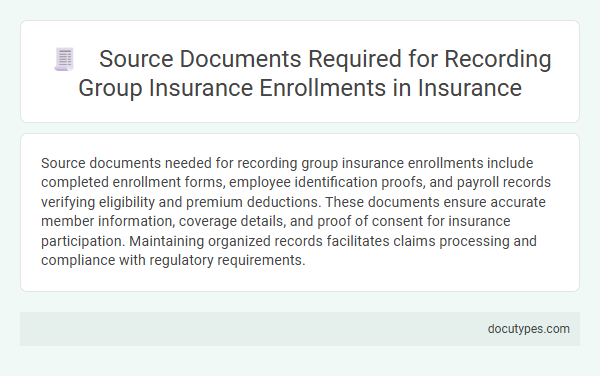Source documents needed for recording group insurance enrollments include completed enrollment forms, employee identification proofs, and payroll records verifying eligibility and premium deductions. These documents ensure accurate member information, coverage details, and proof of consent for insurance participation. Maintaining organized records facilitates claims processing and compliance with regulatory requirements.
Introduction to Group Insurance Enrollment Documentation
Group insurance enrollment requires accurate documentation to ensure proper coverage and record-keeping. Understanding the necessary source documents helps streamline the enrollment process and maintain compliance.
- Enrollment Forms - These forms capture employee details and plan selections necessary for policy activation.
- Proof of Eligibility - Documents such as employment verification or dependent status confirm eligibility for group coverage.
- Authorization Agreements - Signed consent forms authorize payroll deductions and enrollment in the insurance plan.
Importance of Accurate Source Documents
Source documents such as enrollment forms, member identification, and payroll records are essential for accurately recording group insurance enrollments. These documents verify employee eligibility and coverage details, ensuring proper policy administration and compliance with regulatory requirements. Accurate source documents prevent errors, facilitate timely claims processing, and support audit trails for group insurance plans.
Employer’s Enrollment Submission Forms
Employer's enrollment submission forms are essential source documents for recording group insurance enrollments. These forms contain critical information such as employee details, coverage options selected, and effective dates of enrollment. You must ensure these documents are complete and accurate to facilitate proper processing of group insurance policies.
Employee Application and Enrollment Forms
Source documents are essential for accurate recording of group insurance enrollments. Your employee application and enrollment forms provide the primary evidence of coverage details needed for processing.
- Employee Application Form - This form captures personal information, coverage options, and beneficiary details required for enrollment verification.
- Enrollment Form - It records the employee's selected insurance plans and confirms their agreement to the terms and conditions.
- Supporting Identification Documents - These validate the applicant's identity and eligibility, ensuring compliance with policy requirements.
Proof of Eligibility Documentation
Proof of eligibility documentation is essential for accurately recording group insurance enrollments. These documents verify an individual's qualification for coverage under the group policy.
- Employee Identification - Valid government-issued ID or employee badge confirming the individual's identity.
- Employment Verification - Recent pay stubs, employment letters, or contracts proving active employment status.
- Dependent Eligibility - Marriage certificates, birth certificates, or adoption papers verifying dependent relationships.
Maintaining thorough proof of eligibility ensures compliance with insurance carrier requirements and supports smooth enrollment processing.
Beneficiary Designation Forms
What source documents are needed for recording group insurance enrollments? Beneficiary designation forms are essential documents that specify who will receive the insurance benefits. These forms ensure your chosen beneficiaries are officially recorded and protect your intentions in the event of a claim.
Dependent Verification Documents
Source documents are essential for accurately recording group insurance enrollments, especially when verifying dependent information. Proper documentation ensures eligibility and compliance with policy requirements.
Dependent verification documents may include birth certificates, marriage licenses, and legal guardianship papers. You must provide these documents to confirm the relationship between the employee and their dependents for insurance coverage.
Evidence of Insurability (EOI) Requirements
| Source Document | Description | Importance for Group Insurance Enrollment |
|---|---|---|
| Evidence of Insurability (EOI) Form | A detailed questionnaire completed by the employee or member, providing health and medical information. | Verifies eligibility for coverage beyond guaranteed issue limits, ensuring accurate risk assessment. |
| Employer Enrollment Form | Document completed by employers listing employees selecting group insurance coverage and their plan options. | Serves as primary enrollment evidence and confirms group plan participation. |
| Proof of Prior Coverage | Documentation confirming previous group or individual insurance coverage. | Helps determine waiting periods and pre-existing condition limitations linked to EOI assessments. |
| Medical Records or Physician Statements | Optional or required medical documents supporting declarations made in the EOI form. | Validates accuracy of health information for underwriting decisions. |
You must provide a completed Evidence of Insurability form when applying for group insurance benefits that exceed guaranteed issue limits or when late enrolling. This form is critical for underwriting and approval of coverage based on your health status.
Data Privacy and Confidentiality in Source Documents
Source documents necessary for recording group insurance enrollments include completed enrollment forms, proof of eligibility, and signed authorization agreements. These documents ensure accurate data collection for processing and verifying group insurance coverage.
Maintaining data privacy and confidentiality within source documents is crucial to protect sensitive personal information such as Social Security numbers and medical history. Your organization must implement secure handling and storage protocols to prevent unauthorized access and ensure compliance with privacy regulations.
What Source Documents Are Needed for Recording Group Insurance Enrollments? Infographic

